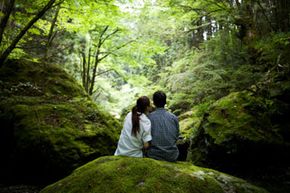 “You’ll find lots of moss in lush, shady areas.Michael Hitoshi/Digital Vision/Getty Images
“You’ll find lots of moss in lush, shady areas.Michael Hitoshi/Digital Vision/Getty Images
You walk down a forested path. Moisture hangs in the cool air, and sunlight struggles to pierce the thick canopy above. The ground is so dense with underbrush that it’s hard to tell where one fern ends and another begins. Ahead, water spills from a fuzzy green ridge; it washes over a fallen tree trunk and laps at the cobblestones beneath your feet. No, you haven’t stepped onto the set of "Avatar"; you’ve simply found an ideal habitat for moss.
If you live somewhere lush and shady, like coastal Washington State, moss needs no introduction; it’s about as ubiquitous as the Starbucks Coffee Company. But folks in more arid climates simply know it as that carpetlike plant that occasionally grows on stuff — the ground, rocks, trees, sidewalks, walls, roofs. While most of the approximately 15,000 species of moss are some shade of green, others can appear rose, yellow, black and even silver. Moss ranges in size from Ephemerum, which grows just 0.02 inches (0.5 mm) tall, to Dawsonia, which may reach a height of 27.5 inches (70 cm) [source: Richardson].
Mosses differentiate themselves from flowering plants and trees by not doing certain things: They don’t anchor themselves with roots; they don’t germinate from seeds; and, they don’t move water and nutrients through a system of internal vessels.
So, then, how exactly does moss work?



























